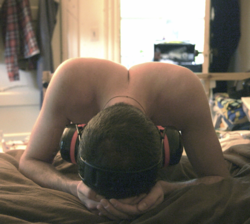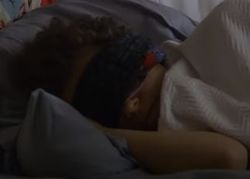Photophobia

Photophobia, also known as light sensitivity, is a symptom of abnormal visual intolerance to light.[1] It can manifest as discomfort or pain. It occurs in ME/CFS as part of a range of sensitivities such as hyperacusis and misophonia (sound sensitivity), and allodynia. Photophobia also forms part of the wide range of ocular symptoms that occur in ME/CFS.
Prevalence[edit | edit source]

- In 1995, Katrina Berne reported a prevalence of 65-90% for 'photosensitivity'.[2]
- In a 2001 Belgian study, 70.7% of patients meeting the Fukuda criteria and 75.8% of patients meeting the Holmes criteria, in a cohort of 2073 CFS patients, reported photophobia.[3]
- A 2013 study by Hutchinson, et al, using a patient population of 59 answering questions on the DePaul Symptom Questionnaire (DSQ) found that the most common vision-related symptom was sensitivity to bright lights with a 92% prevalence.[4]
Symptom recognition[edit | edit source]
Photophobia is not a symptom required for diagnosis in any definition. In the Canadian Consensus Criteria (CCC), it appears under the section Neurological/Cognitive Manifestations and can be used to form a diagnosis.[5] The International Consensus Criteria (ICC) also lists photophobia as a diagnostic criteria, under the section Neurosensory, perceptual and motor disturbances.[6]
- In the Holmes criteria, photophobia is an optional criteria for diagnosis, under the section Minor Symptom Criteria - Neuropsychologic Complaints.[7]
No other definitions mention photophobia.

Notable studies[edit | edit source]
- 2000, Ocular manifestations in chronic fatigue syndrome[10] (Abstract)
- 2013, Vision-related symptoms as a clinical feature of chronic fatigue syndrome/myalgic encephalomyelitis? Evidence from the DePaul Symptom Questionnaire (Abstract)
Possible causes[edit | edit source]
Photophobia can be caused by the pupil dilating rather than contracting when exposed to a light source. Pupil dilation is controlled by the sympathetic nervous system, which is usually hyper-responsive in people with ME/CFS due to an excess of excitatory neurotransmitters.[11]
A magnesium deficiency can cause photophobia, and such deficiency is common in ME/CFS.[12] This can be resolved with appropriate magnesium supplementation.
Some medications have photophobia listed as a side effect, notably benzodiazepines.[13][14]
Photophobia can also often caused by illnesses that are common comorbidities of ME/CFS, such as migraine,[15] fibromyalgia,[16] dry eyes,[16] idiopathic intracranial hypertension which can occur in Ehlers-Danlos syndrome[17], infectious mononucleosis (although this not common),[18][19] chiari malformation,[20] dyslexia[21], and lyme disease.[citation needed]
Potential treatments[edit | edit source]
There are no treatments that specifically target photophobia. It is usually resolved by treating the underlying cause. Treatable causes of photophobia include magnesium deficiency, and when photophobia occurs as a side-effect of medication. If the photophobia is caused by a comorbid illness, treatment may help alleviate the symptom.
In the absence of successful treatment, discomfort can be ameliorated by avoiding bright lights, keeping curtains drawn, and wearing an eye mask or dark glasses. When going outside, wearing dark glasses or other special glasses and hats can help.[11]
See also[edit | edit source]
Learn more[edit | edit source]
- A Girl Behind Dark Glasses Taylor-Bearman, Jessica (July 1, 2017). A Girl Behind Dark Glasses. Hashtag Press. ISBN 9781999805357.
- Prize-winning Animation Released for Severe ME Day[22]
- Shedding Light on Photophobia[23]
- Wikipedia - Photophobia
References[edit | edit source]
- ↑ "photophobia". The Free Dictionary.
- ↑ Berne, Katrina (December 1, 1995). Running on Empty: The Complete Guide to Chronic Fatigue Syndrome (CFIDS) (2 ed.). Hunter House. p. 59. ISBN 978-0897931915.
- ↑ De Becker, Pascale; McGregor, Neil; De Meirleir, Kenny (December 2001). "A definition‐based analysis of symptoms in a large cohort of patients with chronic fatigue syndrome". Journal of Internal Medicine. 250 (3): 234–240. doi:10.1046/j.1365-2796.2001.00890.x.
- ↑ Hutchinson, Claire V; Maltby, John; Badham, Stephen P; Jason, Leonard (2013). "Vision-related symptoms as a clinical feature of chronic fatigue syndrome/myalgic encephalomyelitis? Evidence from the DePaul Symptom Questionnaire". The British journal of ophthalmology. 98 (1). doi:10.1136/bjophthalmol-2013-304439.
- ↑ Carruthers, Bruce. "Myalgic Encephalomyelitis/Chronic Fatigue Syndrome: A Clinical Case Definition and Guidelines for Medical Practitioners - An Overview of the Canadian Consensus Document" (PDF). sacfs.asn.au.
- ↑ Carruthers, BM; van de Sande, MI; De Meirleir, KL; Klimas, NG; Broderick, G; Mitchell, T; Staines, D; Powles, ACP; Speight, N; Vallings, R; Bateman, L; Baumgarten-Austrheim, B; Bell, DS; Carlo-Stella, N; Chia, J; Darragh, A; Jo, D; Lewis, DP; Light, AR; Marshall-Gradisnik, S; Mena, I; Mikovits, JA; Miwa, K; Murovska, M; Pall, ML; Stevens, SR (August 22, 2011), "Myalgic encephalomyelitis: International Consensus Criteria", Journal of Internal Medicine, 270 (4): 327–338, doi:10.1111/j.1365-2796.2011.02428.x, PMID 21777306
- ↑ Holmes, Gary P.; Writing Committee (1988), "Chronic Fatigue Syndrome: A Working Case Definition", Annals of Internal Medicine, 108 (3): 387-389, PMID 2829679
- ↑ Char (November 2, 2017). "ME/CFS flares: what do they feel like and how to cope". Chronically Hopeful. Retrieved October 11, 2018.
- ↑ Taylor-Bearman, Jessica (July 1, 2017). A Girl Behind Dark Glasses. Hashtag Press. ISBN 9781999805357.
- ↑ Mastropasqua, Leonardo; Ciancaglini, Marco; Carpineto, Paolo; Iezzi, Antonella; Racciatti, Delia; Falconio, Gennaro; Zuppardi, Eduardo; Pizzigallo, Eligio (September 2000). "Ocular manifestations in chronic fatigue syndrome". Annals of Ophthalmology. 32 (3): 219–224. doi:10.1007/s12009-000-0059-5. ISSN 1530-4086.
- ↑ 11.0 11.1 Verrillo, Erica (September 14, 2012). "Symptoms - Photophobia". Chronic Fatigue Syndrome: A Treatment Guide (Kindle eBook) (2 ed.).
- ↑ Durlach, Jean; Morii, Hirotoshi; Nishizawa, Yoshiki (March 6, 2007). "10: Clinical forms of Magnesium Depletion by Photosensitization and Treatment with Scototherapy". New Perspectives in Magnesium Research. Springer London. pp. 117–126. doi:10.1007/978-1-84628-483-0_10. ISBN 978-1-84628-388-8.
- ↑ Wakakura M, Tsubouchi T, Inouye J (March 2004), "Etizolam and benzodiazepine induced blepharospasm", J. Neurol. Neurosurg. Psychiatr., 75 (3): 506–7, doi:10.1136/jnnp.2003.019869, PMID 14966178
- ↑ Pelissolo, A; Bisserbe, JC (March–April 1994), "[Dependence on benzodiazepines. Clinical and biological aspects]", Encephale, 20 (2): 147–57, PMID 7914165
- ↑ Drummond, PD (October 1986), "A quantitative assessment of photophobia in migraine and tension headache", Headache, 26 (9): 465–9, doi:10.1111/j.1526-4610.1986.hed2609465.x, PMID 3781834
- ↑ 16.0 16.1 Digre, Kathleen B.; Brennan, K.C. (March 2012). "Shedding Light on Photophobia". Journal of neuro-ophthalmology : the official journal of the North American Neuro-Ophthalmology Society. 32 (1): 68–81. doi:10.1097/WNO.0b013e3182474548. ISSN 1070-8022. PMC 3485070. PMID 22330853.
- ↑ Henderson, Fraser C.; Austin, Claudiu; Benzel, Edward; Bolognese, Paolo; Ellenbogen, Richard; Francomano, Clair A.; Ireton, Candace; Klinge, Petra; Koby, Myles; Long, Donlin; Patel, Sunil (2017). "Neurological and spinal manifestations of the Ehlers–Danlos syndromes". American Journal of Medical Genetics Part C: Seminars in Medical Genetics. 175 (1): 195–211. doi:10.1002/ajmg.c.31549. ISSN 1552-4876.
- ↑ A.D.A.M. Medical Encyclopedia (May 15, 2012). "Mononucleosis". PubMed Health. Archived from the original on January 18, 2013. Retrieved August 7, 2018.
- ↑ Gauthier-Smith, P.C. (December 22, 2004), "Neurological complications of glandular fever (infectious mononucleosis)", Brain, Oxford University Press, 88 (2): 323–334, doi:10.1093/brain/88.2.323, PMID 5828906
- ↑ "Chiari malformation". National Health Service. October 18, 2017. Retrieved December 27, 2021.
- ↑ "Light sensitivity — photophobia". Royal National Institute of Blind People.
- ↑ "Prize-winning Animation Released for Severe ME Day - Prohealth". Prohealth. August 11, 2018. Retrieved August 16, 2018.
- ↑ Digre, Kathleen B.; Brennan, K.C. (2012). "Shedding Light on Photophobia". Journal of neuro-ophthalmology : the official journal of the North American Neuro-Ophthalmology Society. 32 (1): 68–81. doi:10.1097/WNO.0b013e3182474548. ISSN 1070-8022. PMID 22330853.

